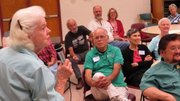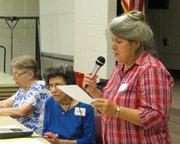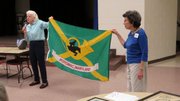Most of the close to 70 people gathered for a Potomac Community Village meeting on Thursday, Aug. 28, have lived in Potomac for more than 25 years. Some have lived here for more than 40 years. But that wasn't long ago enough to match the recollections of Elie Cain, who told those assembled what Potomac was like when she arrived with her family in 1938.
"The beer parlor was where Mitch and Bill's [gas station] is now," she said, recalling that because of the beer parlor, the Falls and River crossroads in those days was considered rowdy. Back then, "there were a lot of dirt roads. River Road ended being paved at Piney Meeting House, and Piney Meeting House was dirt. Bells Mill Road was also a dirt road then," she said.
She recalled that farming was not profitable. "Farming was always a struggle. The soil is not of high quality — it's wonderful Maryland clay. People sold off their farms and Potomac became residential for people who worked in Washington, D.C."
Cain was one of three people who spoke about Potomac's history during the Potomac Community Village meeting. The non-profit group has a mission of helping residents of the Potomac community remain in their homes and live with dignity as they get older. It hosts monthly meetings at the Potomac Community Center for interested community members.
The other speakers were Jill Phillips and Ginny Barnes.
Phillips, who introduced Cain and Barnes, told those attending that a "History of Potomac" had been published by the Potomac Almanac back in 1970, and copies of it were available on Amazon. She suggested that attendees and other community residents who had Potomac history stories could share them through Potomac Community Village.
Barnes, who has lived in Potomac since 1966 in a house that was once a lockkeeper's, had the opportunity to interview many Potomac "old-timers" 25 years ago when they were then in their 80s and 90s, and she shared some of their recollections.
"They were farmers and the children of tenant farmers who moved from farm to farm in the first part of the 20th century," Barnes said. "Horses worked the land back then, and they bartered for what they needed. They took corn and wheat to the Glen Mill to be ground into meal and flour. They cut ice off the Glen Mill Dam and stored it in ice houses on the farm for refrigeration."
In answer to the question, where was Glen Mill, Barnes responded, "Go down South Glen Road, cross the bridge and turn left."
Barnes then played a recording from a 1990 interview with Lavinia Robey, who had grown up in a house on Falls Road, and spoke about her father and what happened on Christmas Day of 1904.
"It was bitter cold," said Robey, "and Father had on a big fur cap, and suddenly a bullet came and hit him in the head. People started screaming and said Poppa had been shot. Someone got on a horse and had to ride all the way into Rockville to get the doctor."
The doctor came and "operated on him on the kitchen table and took out the bullet, and we still have that bullet."
What saved him, said Robey, was the fur hat, which slowed down the bullet and kept it from doing great harm to her father. The gunfire was from someone who "was drinking and celebrating Christmas," she said.
Cain also displayed Potomac's flag, after discovering that almost none of those attending even knew there was one.
Created in 1989 for a Potomac Day celebration, the flag's colors of red, black and yellow are derived from the colors of the Maryland state flag, plus the green to represent that Potomac is in one of the green wedges and not the transportation corridors of Montgomery County's "wedges and corridors" development plan, Cain said.
"The cross represents the crossroads of Falls and River, and the horse is jumping through a hunting horn," she said.
Cain has been active in Potomac for many years, working with, among other groups, the Potomac Theater Company, the Potomac Master Plan Advisory Group and Friends of the Great Falls Tavern.
Cain's father, F. Moran (Mike) McConihe, developed the Potomac Village Shopping Center in 1949 and donated the land for the construction of St. Francis Episcopal Church in 1954. Her mother, Margo, was one of the founders of the Potomac Country House Tour. Both were instrumental in founding the Potomac Hunt in the early 1940s.
Barnes served as president of the West Montgomery County Citizens Association for many years and is currently its environment chair. She was active in the effort to prevent the widening of Glen Road and retaining the one-lane bridge over Watts Branch.
Potomac Community Village's next meeting, on Thursday, Sept. 18, is entitled "Seven Steps to Better Brain Health," and focuses on enhancing memory as we age. For more information about Potomac Community Village, see www.PotomacCommunityVillage.org or call 240-221-1370.




